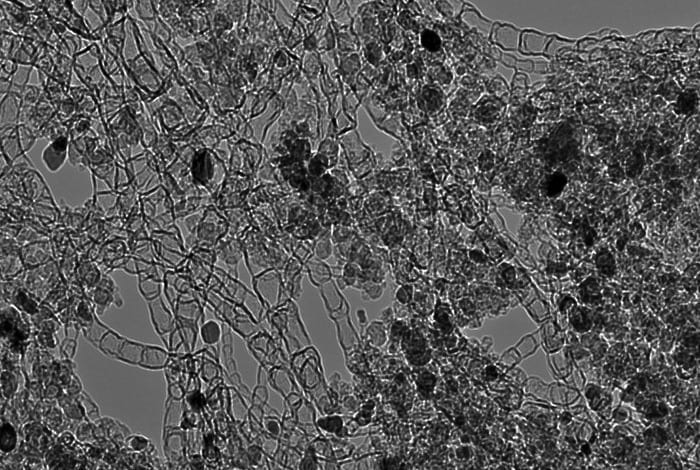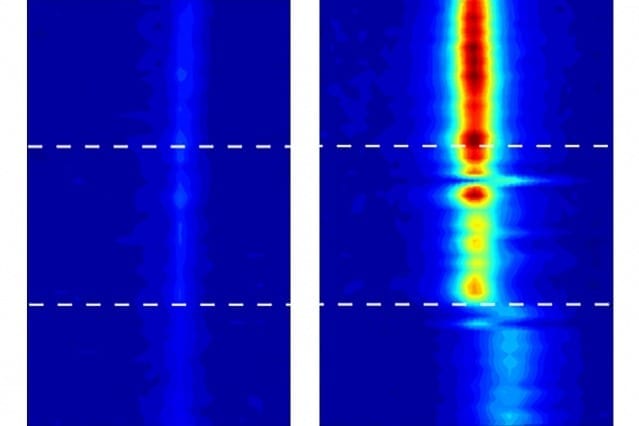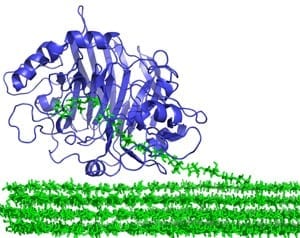
The new material has the highest oxygen reduction reaction (ORR) activity in alkaline media of any non-precious metal catalyst developed to date.
Economical non-precious-metal catalyst capitalizes on carbon nanotubes
Los Alamos National Laboratory scientists have designed a new type of nanostructured-carbon-based catalyst that could pave the way for reliable, economical next-generation batteries and alkaline fuel cells, providing for practical use of wind- and solar-powered electricity, as well as enhanced hybrid electric vehicles.
In a paper appearing recently in Nature Communications, Los Alamos researchers Hoon T. Chung, Piotr Zelenay and Jong H. Won, the latter now at the Korea Basic Science Institute, describe a new type of nitrogen-doped carbon-nanotube catalyst. The new material has the highest oxygen reduction reaction (ORR) activity in alkaline media of any non-precious metal catalyst developed to date. This activity is critical for efficient storage of electrical energy.
The new catalyst doesn’t use precious metals such as platinum, which is more expensive per ounce than gold, yet it performs under certain conditions as effectively as many well-known and prohibitively expensive precious-metal catalysts developed for battery and fuel-cell use. Moreover, although the catalyst is based on nitrogen-containing carbon nanotubes, it does not require the tedious, toxic and costly processing that is usually required when converting such materials for catalytic use.
“These findings could help forge a path between nanostructured-carbon-based materials and alkaline fuel cells, metal-air batteries and certain electrolyzers,” said Zelenay. “A lithium-air secondary battery, potentially the most-promising metal-air battery known, has an energy storage potential that is 10 times greater than a state-of-the-art lithium-ion battery. Consequently, the new catalyst makes possible the creation of economical lithium-air batteries that could power electric vehicles, or provide efficient, reliable energy storage for intermittent sources of green energy, such as windmills or solar panels.”
The Latest Bing News on:
Carbon-nanotube catalyst
- Single-walled carbon nanotubes doped with 'nitrogen' enhance the performance of secondary battery anodeon April 24, 2024 at 9:27 am
Researchers have developed a new manufacturing technique for "silicon/nitrogen-doped carbon composite anode materials." These materials aim to enhance the capacity and stability of lithium-ion battery ...
- Scientists stencil-paint carbon nanotube components for flexible transparent electronicson April 23, 2024 at 9:23 am
Researchers from Skoltech, MIPT, and elsewhere have found a fast and inexpensive way to create geometric patterns in carbon nanotube films. The resulting films turned out to have superior properties ...
- Dimethylformamide Market to Boom: PU Leather in Luxury Cars Drives Growth with CAGR of 4.8%on April 23, 2024 at 2:06 am
The dimethylformamide (DMF) market is poised for substantial growth between 2023 and 2033, with an expected CAGR of 4.8%. By 2033, it is projected to reach a market share of US$ 627.7 million, ...
- How to ensure readiness of next-generation defense technology: Solving the issue of massive heat.on April 22, 2024 at 7:33 am
High-performance systems generate tremendous amounts of heat that can compromise missions and make high-tech systems less effective in tactical environments. But there is a solution to this modern-age ...
- 'Nano stitches' enable lighter and tougher composite materialson April 16, 2024 at 8:12 am
To save on fuel and reduce aircraft emissions, engineers are looking to build lighter, stronger airplanes out of advanced composites. These engineered materials are made from high-performance fibers ...
- Carbon-based supports for electrocatalysis under industrially relevant conditionson March 19, 2024 at 12:30 pm
Carbon materials, due to their appropriate physicochemical characteristics such as high surface area, adjustable pore structure, variable morphology, and multifunctional surface properties based on ...
- Revolutionary Carbon Nanotube Sheet Recyclabilityon March 19, 2024 at 9:16 am
High-performance carbon nanotube (CNT) sheets can be recycled while maintaining their shape, structural alignment, mechanical and electrical capabilities, and inherent flexibility, according to ground ...
The Latest Google Headlines on:
Carbon-nanotube catalyst
[google_news title=”” keyword=”carbon-nanotube catalyst” num_posts=”10″ blurb_length=”0″ show_thumb=”left”]
The Latest Bing News on:
Energy storage
- Energy storage plant plans recommended for approvalon April 26, 2024 at 9:33 am
Plans for the construction of an energy storage plant have been recommended for approval. The proposals for the Greener Grid Park in Necton, Norfolk, were unveiled last year with the aim of supporting ...
- IEA calls for sixfold expansion of global energy storage capacityon April 26, 2024 at 9:04 am
The International Energy Agency (IEA) has issued its first report on the importance of battery energy storage technology in the energy transition. It has found that tripling renewable energy capacity ...
- Energy firm's battery storage site plans approvedon April 26, 2024 at 4:02 am
Exagen has been granted permission to go ahead with plans for 16 lithium-ion battery units on land in Brockworth.
- Clean energy developer to transform former mine into massive clean energy storage project: 'Will help ensure people have energy when they need it'on April 26, 2024 at 3:15 am
"Storing and generating on-demand electricity, which can be used in any number of ways." Clean energy developer to transform former mine into massive clean energy storage project: 'Will help ensure ...
- Schneider Electric Launches All-In-One Battery Energy Storage System (BESS) for Microgridson April 25, 2024 at 11:07 pm
Schneider Electric, the global leader in digital transformation of energy management and automation, today announced the launch of its latest ...
- NV Energy aims to reduce customer costs, save energy with new solar battery storage facilityon April 25, 2024 at 6:01 pm
"We have been working with various stakeholders to be very aggressive in trying to add resources like the one we're here celebrating today," NV Energy CEO Doug Cannon told Channel 13.
- Disrupting Energy Storageon April 25, 2024 at 10:05 am
There’s a great deal of research taking place with battery technologies to find a viable alternative to lithium-ion (Li-ion) batteries, which will find its way to the power ...
- Battery energy storage developments that are electrifying the sectoron April 25, 2024 at 6:59 am
Battery energy storage is vital for a clean energy future. Kit Million Ross explores new developments in the sector.
- Stretchy power! Wearables get flexible energy storage in new breakthroughon April 25, 2024 at 5:53 am
Micro supercapacitors have emerged as a promising alternative providing higher power density, rapid charging capabilities, and long lifespan.
- High-energy-density capacitors with 2D nanomaterials could significantly enhance energy storageon April 24, 2024 at 2:06 pm
In the quest for more efficient and sustainable energy solutions, a multi-university research team has reached a significant milestone in capacitor technology. Researchers from the University of ...
The Latest Google Headlines on:
Energy storage
[google_news title=”” keyword=”energy storage” num_posts=”10″ blurb_length=”0″ show_thumb=”left”]










